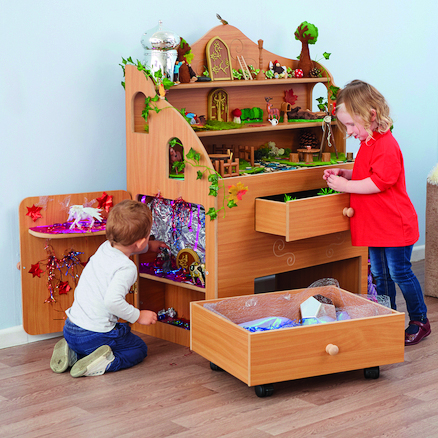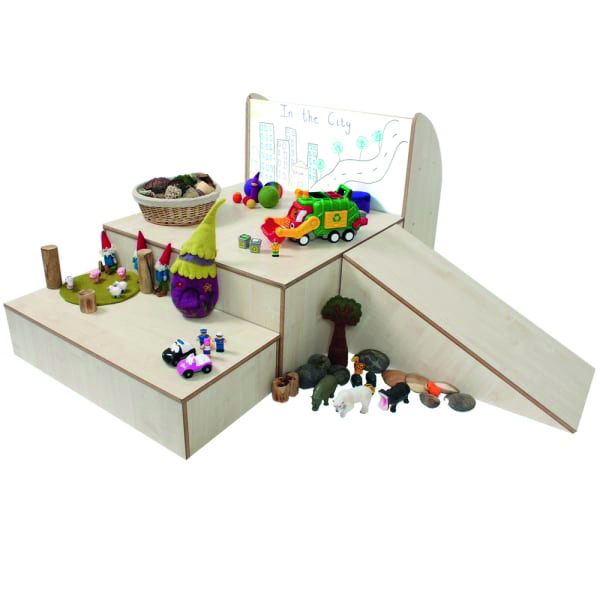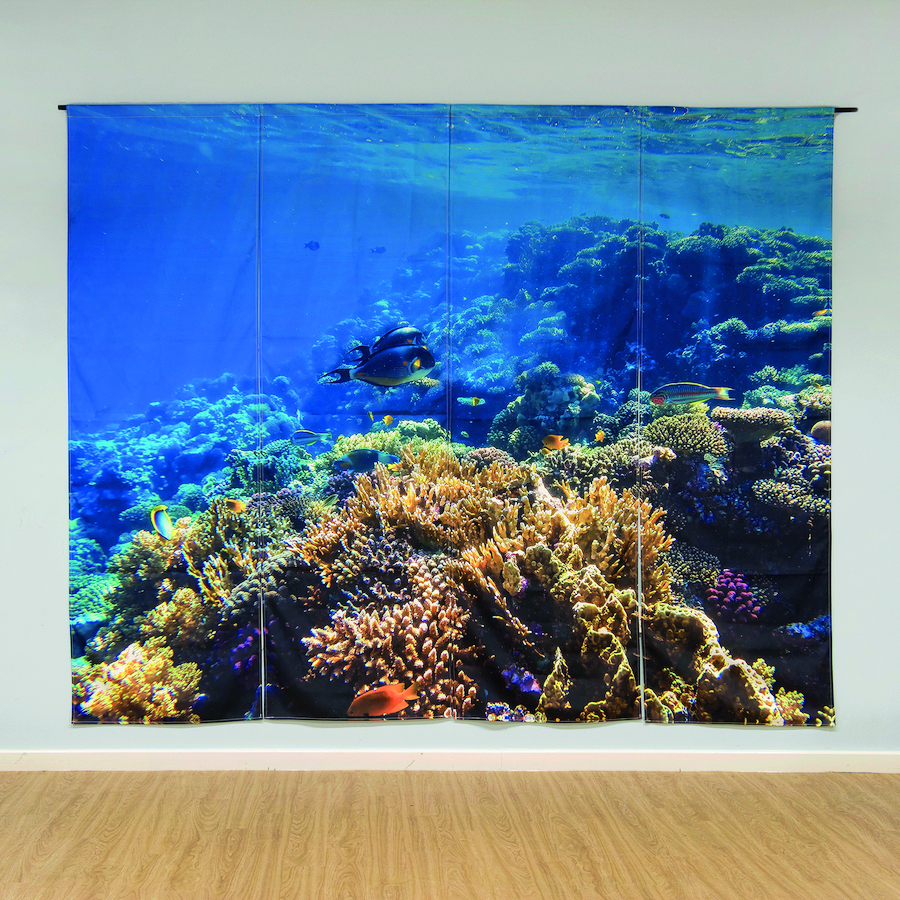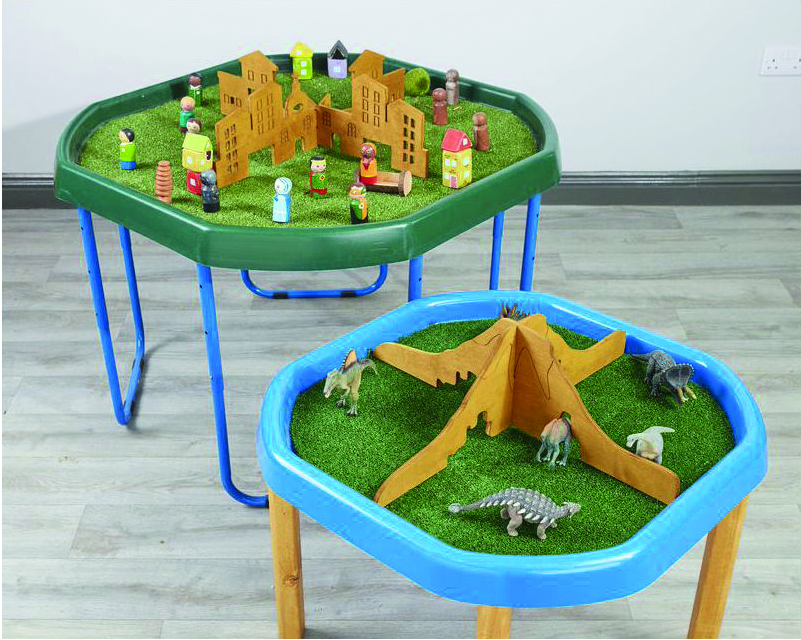
Small-world play is an invaluable part of classroom provision – both in the form of continuous provision and as enhancement. By providing a rich range of resources, practitioners can model how to create scenes which can enhance and deepen children’s play and lead to a greater understanding of the world.
‘If we think of small-world play areas as being story factories,’ explains Phil Armstrong of Early Excellence, ‘setting the scene becomes the landscape for those stories to take place. From here, children can draw on their imaginations and experiences and be involved in rich, sustained play.’
PRETEND PLAY
Development Matters(2020) highlights small-world play in the context of pretend play and gives an indication of what is developmentally appropriate for children at different ages:
- 2 years-plus Children generally start to understand the difference between pretend and real.
- 3-4 years Children generally start to develop pretend play with ‘rules’. Offer small-world equipment such as animal sets, dolls and dolls’ houses so that children can begin to develop their own complex stories.
Alison Gopnik, internationally recognised leader in the study of children’s learning and development and professor of psychology at the University of California, Berkeley, did a study on pre-school children and pretend play.
With her colleagues, she found that pretend play is related to a specific but important type of learning and reasoning, known as ‘counterfactual reasoning’. This is when children immerse themselves in imaginary worlds and consider what would happen if the world were different. In doing so, they work out the consequences.
Ms Gopnik found that children who engaged more in pretend play were better at thinking about things that could have happened but didn’t, which are skills that adults use in their everyday thinking. For example, ‘What would have happened if I forgot to bring my passport to the airport?’ Or, ‘If I hadn’t missed the bus, I would have got here on time.’
SMALL WORLD
There are many benefits to engaging in small-world play, but here are some of the key ones. It:
- promotes rich opportunities for developing children’s natural desire to create stories and narrate
- offers children the opportunity to be ‘in control’ of their play and to use their imagination to make ideas happen
- is a place where children can make prior knowledge explicit and where they can construct new knowledge
- enables children to sort, order and manipulate a world that they do not inhabit themselves.
SETTING THE SCENE
Combining resources to create environments that develop and inspire children’s imaginations will significantly heighten their learning potential.
While it may be fun to play with a lone small pirate figurine, if children are encouraged to create a landscape around the story that they have made up, they are able to get deeper into the narrative, which in turn will help them to develop a sense of self; stronger vocabulary and ability to think creatively.
Practitioners could encourage them to create a ship for the pirate to sail on, make an ocean out of strips of blue fabric and add another boat for the pirate ship to go into battle with. This will heighten their play experience.
When thinking about how to offer small-world play, as well as considering the inhabitants of the miniature world and how to create the landscapes, practitioners need to consider the containers that will be used for holding the small-world environment.
CONTAINERS

Given the variety of possible landscapes that children can create, settings need to have at the ready a large variety of containers capable of housing these miniature worlds.
Angelica Celinska, educationalist at TTS Group, suggests considering containers at different heights with standing, sitting and kneeling options for children. ‘A tuff tray on an adjustable stand, for example, allows children to be more active as they play,’ she says.
Consider, for example, tuff spots or builder’s trays: large, shallow octagonal trays provide enough space for several children to play alongside each other, on their own or in pairs; available from large DIY stores and early years suppliers, e.g.:
- Tuff Tray, £13.99, with a range of interchangeable mats, including the Dinosaur Jurassic Tuff Tray Mat, £19.99 (pictured), and Tuff Tray Stand with Adjustable Legs, £46.99, all from Early Years Resources.
- TTS’s Active World Tuff Tray Outdoor Table, £539.95; or try the extensive range of tuff tray bundles, including the Small World Treasure Island Tuff Tray Bundle, £84.95.
- Cosy stocks a range of tuff spots of different heights. Try the Indoor Wooden Tuff Spot Stands (3pk), £117.99, and Deep Spot Trio (3pk) with trays, £114.95.
- Sand or water trays or large plastic boxes can be used if you can’t afford a tuff spot, but smaller trays may restrict the scope for imagination. Examples of large trays include:
- Jumbo Tray Rectangle, £7.99; Small Shallow Tub Trug, £11.99; Handy Tray, £7.99 – all from Early Years Resources.
- Plastic trays – sand trays, growbag trays, cat litter trays (unused), potting trays, flowerpot saucers, washing-up bowls, tea trays and jelly moulds.
- Sustainable options include wooden cable drums, which are the ideal height for children to set up a small-world play scene and play collaboratively. Alternatively, hollowed-out logs can be used outdoors to create fairy gardens or minibeast habitats.
- The Longworth Cable Drum, £41.99, from Cosy, complete with Astroturf, aims to make small-world set-ups easy. Or try drilling a tuff spot into Cosy’s Tuff Spot Cable Drum 2, £39.99, or placing Cosy’s Trio of Trays (3pk), £74.99, on top.
- The Magic Tree Small World Table, £299.95, from TTS is useful for setting up different-themed seasons.
- Workstations – units that combine storing small-world resources with an area to play – are useful space-saving options:
- Alice Sharp’s Small World Discovery Unit, £409.95, from TTS (pictured), contains a secret opening, ledges and cut-out windows to peer through into magical worlds. Or try the Mirrored Storage Unit, £299.95, also from TTS.
- Try Cosy’s Tall Storage, £69.99.
- Or Active Play Platforms and Ramp Set, £259.99, from Early Years Resources (pictured).
- Meanwhile, backdrops are useful for setting the scene on a larger scale, e.g.:
- The TTS range of Immersive Environments Backdrop Under The Sea, £60.95 (pictured).
- Early Years Resources’ range of backdrops, including the Summer Scene Setter Panel, £40.99

Other ideas: biscuit tins, baskets, rugs, carpet tiles, baking trays, car tires, suitcases, shoeboxes, hats, cardboard egg trays, flowerpots and chocolate boxes.
CASE STUDY: Busy Bees Ledbury, Herefordshire
Emma Davis, small-world enthusiast and manager of independent charity setting Busy Bees Ledbury, regularly uses cable reels and tuff trays to set up provocations based on children’s interests. The beauty of these containers, she says, lies in the fact that they can easily be transported from indoors to out and they allow for collaborative play.
She says, ‘Children have recently been interested in searching for minibeasts. To extend their interest, I set up an outdoor small world in a tuff spot, on top of a cable reel. This was close to the digging pit where the area of interest originated, in order to encourage these children to explore the small-world provision. It included logs, sticks, sand, toy minibeasts, pine cones, wood slices and flowers. These resources had been enjoyed in the digging area and mud kitchen, so it was good to combine them in a small-world activity to observe how the play evolved.
‘The first thing I noticed was the number of children engaging who wouldn’t normally show an interest in small-world play. Often, these children use the outdoors as space to run, be free and make noise. However, this activity inspired a much different type of play – quieter, more considered, rich, meaningful, collaborative and thoughtful. Their interactions with other children involved descriptive words, taking on a role, sharing ideas and playing along to a narrative.’
Small-world prize draw

Cosy Direct is offering Nursery World readers the chance to win a pack of Superhero City Scape & Volcanoes and Caves (2pk) to add to your tuff spot for small-world play, worth £29.99. To enter the draw, email ideas@cosydirect.com.
SPECIAL OFFERS
- Siren Films (https://sirenfilms.co.uk) has a special offer for Nursery World readers. Clips of the following films are available for free until 31 May: What does emerging pretend play look like?; Pretend the baby was in the cupboard; Playing with what they know; and Alison Gopnik – Why is pretend play so important? You can download them without a code. You can also take up the 30-day free trial
- Other resources: Early Excellence offers a free Small World Audit Tool. For more details, visit https://earlyexcellence.com/small-world-audit-tool-3-5yrs. To buy a copy of The EEx Guide to Continuous Provision, £35, visit https://earlyexcellence.com/the-eex-guide-to-continuous-provision









